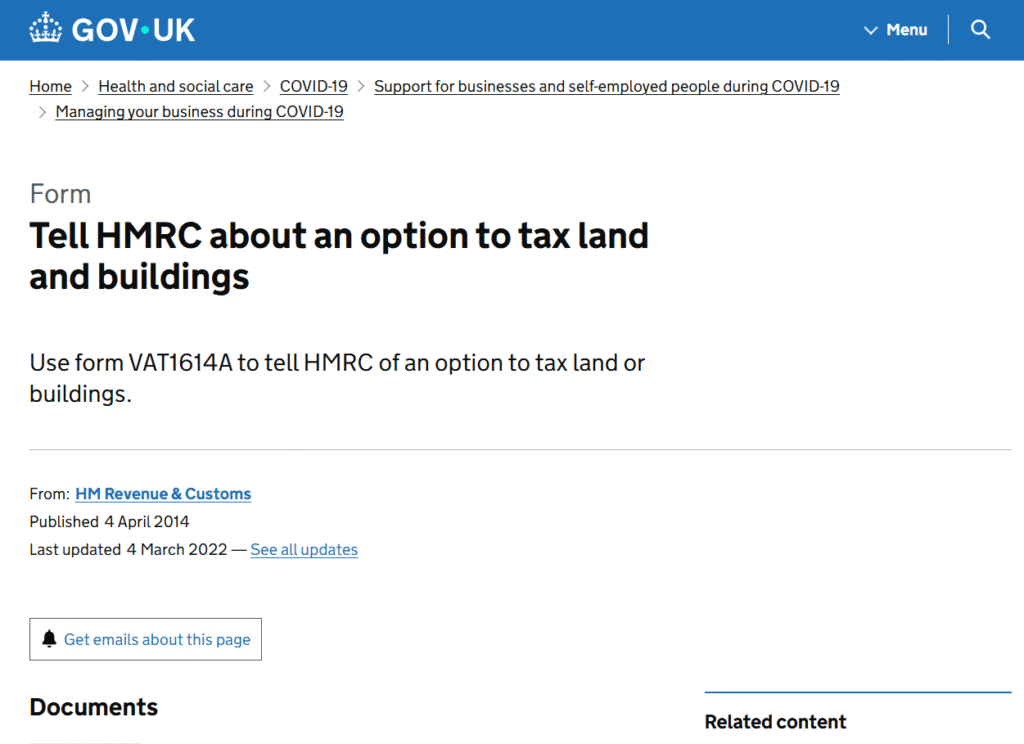VAT1614A Form Assistance – Option to Tax Land and Buildings
The VAT1614A form (commonly referred to as the form VAT1614A) is an official HMRC document used when a business decides to “opt to tax” land or buildings. By opting to tax, you choose to charge VAT on supplies related to a property (such as rent or sale), which also allows you to recover input VAT on related costs.
What is the VAT1614A Form?
The vat1614a is the notification form businesses must submit to HMRC to confirm their decision to opt to tax land or property. Once HMRC acknowledges this, your property dealings (sale, rent, lease) become subject to VAT at the standard rate.
This can be beneficial for businesses that incur significant VAT on building costs, renovations, or purchases, allowing them to reclaim input VAT.
When Should You Submit Form VAT1614A?
You must complete and submit vat1614a form if:
- You decide to charge VAT on rental income.
- You plan to sell a commercial property and want to opt to tax.
- You want to recover VAT on construction, refurbishment, or purchase costs.
Important: Once made, an option to tax usually lasts for 20 years and cannot easily be revoked.
How to Complete the VAT1614A Form
- Download the form directly from HMRC
- Fill in property details – address, title, and type of interest (freehold, leasehold).
- State your reason for opting to tax (e.g., reclaim VAT on purchase).
- Provide business and VAT registration details.
- Submit via email or post to HMRC (details provided on the form).
Key Recommendations
- Always keep a copy of your submitted form VAT1614A for records.
- Ensure you fully understand the long-term implications – opting to tax is binding for 20 years.
- If you rent to charities or tenants using the property for exempt purposes, think carefully – VAT may make rents less attractive.
- Seek professional advice before submission, especially for complex property transactions.
Common Mistakes with VAT1614A
- Submitting the form without fully understanding the long-term tax implications.
- Forgetting to notify HMRC properly – an unacknowledged option to tax may be invalid.
- Applying VAT on exempt supplies, such as residential property or certain charitable uses.
- Missing deadlines when the property transaction is time-sensitive (e.g., completion of sale).
Example Cases
Case 1 – Commercial Office Sale
A company sold a commercial building. By submitting VAT1614A, it opted to tax and reclaimed £50,000 in input VAT on prior refurbishments.
Case 2 – Landlord with Business Tenants
A landlord renting offices used the form vat1614a to charge VAT on rent and recover VAT on service charges.
Case 3 – Property Developer
A developer used VAT1614A to ensure VAT could be reclaimed on substantial building works.
FAQ – VAT1614A
Q1: Can I revoke an option to tax after submitting VAT1614A?
Only in very limited circumstances (e.g., within a short cooling-off period or after 20 years).
Q2: Does opting to tax apply to residential properties?
No – residential properties remain VAT exempt.
Q3: Do I need to notify tenants?
Yes, tenants should be informed if VAT will be added to rent.
Q4: How long does HMRC take to process VAT1614A?
Typically 2–4 weeks, depending on workload.
Q5: Can Audit Consulting Group help with VAT1614A?
Yes – we handle everything from form preparation to HMRC submission and property VAT planning.
Why Choose Audit Consulting Group?
Opting to tax can be complex, and mistakes may be costly. At Audit Consulting Group, we:
- Review whether opting to tax benefits your business.
- Accurately complete and file the vat1614a form.
- Liaise with HMRC on your behalf.
- Provide long-term VAT planning for property investments.
Contact us today – we’ll ensure your form VAT1614A is submitted correctly and your VAT strategy works for your business.
Official HMRC form and guidance: https://www.gov.uk/government/publications/vat-notification-of-an-option-to-tax-land-andor-buildings-vat1614a





